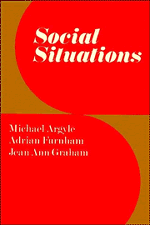Book contents
- Frontmatter
- Contents
- Preface
- 1 Introduction
- 2 The analysis of social situations
- 3 The effect of the situation on behaviour
- 4 Drives and goals
- 5 Rules
- 6 Role-systems
- 7 Repertoire of elements
- 8 Sequences of interaction
- 9 Concepts and cognitive structures
- 10 Environmental setting
- 11 Language and speech
- 12 Stressful situations
- 13 Applications of situational analysis
- 14 Conclusions
- References
- Names index
- Subject index
11 - Language and speech
Published online by Cambridge University Press: 01 June 2011
- Frontmatter
- Contents
- Preface
- 1 Introduction
- 2 The analysis of social situations
- 3 The effect of the situation on behaviour
- 4 Drives and goals
- 5 Rules
- 6 Role-systems
- 7 Repertoire of elements
- 8 Sequences of interaction
- 9 Concepts and cognitive structures
- 10 Environmental setting
- 11 Language and speech
- 12 Stressful situations
- 13 Applications of situational analysis
- 14 Conclusions
- References
- Names index
- Subject index
Summary
Introduction
Linguists since Saussure (1916) have distinguished between language (langue), the underlying system of shared grammatical and other rules, and speech (parole), which is the way people actually talk. While grammarians take as their data idealised utterances which are generally regarded as acceptable, sociolinguists have studied the actual speech systems used by different social groups, in different situations.
It is obvious that language is used in a variety of ways in different situations. The same individuals will talk quite differently when discussing a technical problem at work, playing a game, or drinking beer. In some cultures they use different languages for different situations; in most cultures there are ‘high’ and ‘low’ speech styles for formal and informal situations. The form of language used varies with the role relations of those speaking (e.g. parent–child, husband–wife), as well as with the physical channel used (e.g. the telephone). We have pursued a functional explanation of rules and repertoire, and we shall now explore a functional model of language in relation to the goals of situations.
Sociolinguists have collected samples of speech in different settings. For example, Labov (1972b) used the methods of informal interviews, group discussion between friends, unsystematic observation and asking people to read passages and word lists. He describes an ‘observer's paradox’, the difficulty of finding out how people talk when they are not being observed, which can only be overcome by systematic observation.
- Type
- Chapter
- Information
- Social Situations , pp. 293 - 318Publisher: Cambridge University PressPrint publication year: 1981

